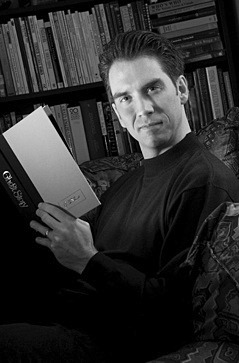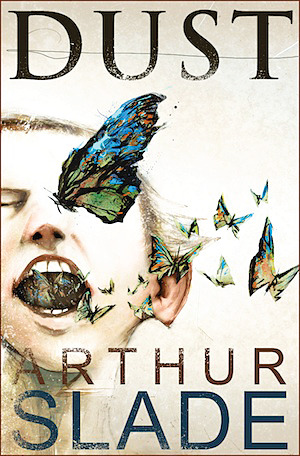Can Write: Meeting Canadian Writers and Illustrators of Children’s Books
What inspires the writers of the books your students read? How does an illustrator decide what to draw? Is it true that most authors and illustrators don’t know each other? This column features a different Canadian children’s book creator in each issue and shows you the story beyond the covers.
Meet Canadian Author Arthur Slade
Arthur Slade lives in Saskatchewan where he writes books such as Loki Wolf, Dust and Island of Doom. Who is the person lurking behind these intriguing titles?
Margriet: You look way too young to have written so many books! Did you know early on that you wanted to be a writer?

Arthur Slade
Arthur: Aging is all in the mind and in how you photoshop your photos! I do now have seventeen books out. Some longer, some shorter. But all were a great mixture of work and joy and work and fun and… well, that’s what writing is all about. I did know when I was sixteen that I wanted to be a writer. The important part of that declaration was that I wanted to make a living as a writer. So that has been my goal since high school. Of course, not an easy goal so it took me about fourteen years before I could actually make a living at it.
Margriet: What is your favourite genre to write? What age is your audience?
Arthur: My favourite genre is whichever one I’m working on at the time. I enjoy writing about history or at least to have an historical aspect to my story. That allows me to use my historical research as a way to procrastinate from writing. Most of my books have a fantastical/supernatural element to them, so obviously I like sending my mind in that direction. I blame that on all the Ray Bradbury books that I read as a child. And as an adult. The audience for my books is ages ten and up, though that depends on the topic, of course. And I’m told that they have “boy appeal.” I assume that’s because I’m a boy and I tend to write about boy things. But even when the main character is female the boys still seem to want to read them. So that must be because I include enough action to keep readers reading. I just want to tell a good story to readers, regardless or their age or gender.
Margriet: Many of your books appear as iBooks. Do you feel that reading has changed much since you were a young boy frequenting the library in Tompkins, Saskatchewan?
Arthur: I admit that I am somewhat of a geek. Okay, I’m totally a techie geek. I’ve found the Internet to be frustrating in the way it can consume your time, but there are also so many new ways to express creativity: podcasts, videos, animations. I’m always looking for new ways to take those communication tools and explore another aspect of a novel for readers. For example I put together short radio stories from The Hunchback Assignments. It was great fun working with actors, mixing everything together and releasing the new material on the web.
Margriet: What does an average workday look like? Do you write all day? Are you a disciplined writer?
Arthur: If everything goes perfectly (and it never does) I get up at 6:00 and start writing until noon or so. With breaks for breakfast and tea and all that jazz. So the actual writing time may vary. I spend afternoons doing the bookkeeping aspects of writing: organizing tours, paying bills, all that glorious stuff. Oh, and tweeting. Though I may do some of my social networking in the morning after 11:00. Generally I work Monday to Saturday. The odd thing is that I do all of this on a treadmill desk. That’s right, I write and walk at the same time. It’s very daring! Maybe I could join a writer’s circus!
Margriet: Your books often encompass myths as well as science. Tell me about the research you do.
 Arthur: Research is so important for laying the foundation of any novel. Even if it is supernatural (like Dust) I work hard to get every detail correct. That way the reader falls right into the world and believes that it’s real and is more likely to believe that the story itself is real. I will read many books about a time period (including details about what people ate or what they wore). I listen to music from that time and read journals so that I get the voice of the people who lived there. It’s very important to me to immerse myself in that history so that it becomes second nature to write about it. The real trick is to figure out when to stop researching and start writing.
Arthur: Research is so important for laying the foundation of any novel. Even if it is supernatural (like Dust) I work hard to get every detail correct. That way the reader falls right into the world and believes that it’s real and is more likely to believe that the story itself is real. I will read many books about a time period (including details about what people ate or what they wore). I listen to music from that time and read journals so that I get the voice of the people who lived there. It’s very important to me to immerse myself in that history so that it becomes second nature to write about it. The real trick is to figure out when to stop researching and start writing.
Margriet: Which is your latest book or upcoming book?
Arthur: My next book is titled Flickers and is all about the flicker shows in Hollywood. Set in 1926, it tells the story of a director who makes the first sound movie, a horror movie. But the scream of the little girl who stars in the movie opens up a new dimension and something (or someone) walks through. So it’s a mixture of history and horror.
Margriet: What do you do during a school visit?
Arthur: That’s where my geeky side really comes out. I usually bring in my iPad, hook it up to a projector and sound system and do an audio-video extravaganza about writing, the history behind my books, and about reading, too. Just imagine lots of explosions going off (not real ones, of course). It’s enjoyable to play around with the technology to sell reading to the students.
Margriet: What do you read?
Arthur: Everything. Magazines about science. Books about history. Other young adult novels. Science fiction, fantasy, reality. One never knows where the next idea will come from.
For more information, check out: arthurslade.com
ABOUT THE AUTHOR
Margriet Ruurs
Margriet Ruurs is the author of 28 books for children. She conducts author presentations in schools around the country. margrietruurs.com.
This article is from Canadian Teacher Magazine’s Apr/May 2014 issue.












